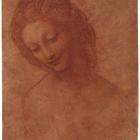Leonardo da Vinci?, Head of Leda
Leonardo da Vinci? (1452-1512), Head of Leda, red chalk on red prepared paper, 200x157 mm (inv. n. 3805 bis)
The earliest reference in the public collections to this "unfinished” sanguine drawing in the style of the school of Leonardo, appears in the first guide to the Municipal Art Museum in 1879.
Initially attributed to Sodoma, it was later recognised by Adolfo Venturi as being a study for the head and half bust for Leda and the Swan by Leonardo da Vinci. The lost work by the Florentine master is known only from antique painted copies and some original sketches. Some have attempted to attribute the drawing to the circle of Cesare da Sesto, that of Gianpietrino or that of Francesco Melzi, Leonardo’s most faithful pupil and heir to all of the master’s manuscripts and drawings.
The sketch, on red prepared paper, is an impressive display of drawing technique executed using red chalk, of which Leonardo was the first to explore the potential and the knowledge of which he passed on to his circle. The recent restoration of the drawing conducted by the Opificio delle Pietre Dure in Florence has brought to light the quality of the execution, highlighting stylistic traits typical of the manner of Leonardo, such as signs of incision, the hatching, the soft and homogeneous distribution of the shading and the detailed plaiting of the hair.








